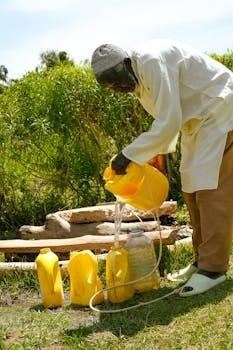Understanding Duramax Diesel Particulate Filter (DPF) Regeneration
The Duramax DPF regeneration process is essential for reducing harmful emissions. It involves burning off accumulated soot. This process can occur automatically, but sometimes requires manual intervention to ensure the DPF is clean and functional.
What is DPF Regeneration?
DPF regeneration is the process of removing accumulated soot from the diesel particulate filter (DPF). This filter traps harmful particles from the exhaust. During regeneration, high temperatures are used to burn off this soot, converting it into ash. This process is crucial for maintaining the efficiency of the emissions system and preventing the filter from clogging. It is a normal part of diesel engine operation and can occur passively, actively, or manually when needed for the Duramax.
Types of Duramax Regeneration
Duramax engines utilize three main types of regeneration⁚ passive, active, and manual. Each type serves to clear soot from the DPF, but they are triggered under different circumstances and conditions.
Passive Regeneration
Passive regeneration occurs automatically during normal driving conditions when the exhaust temperature is high enough to burn off the accumulated soot in the DPF. This usually happens during extended highway driving at speeds above 30 mph (50 km/h). The system cleans itself without any driver input. The vehicle’s computer monitors the system and determines when conditions are suitable for a passive regeneration to take place, making it seamless and efficient.
Active Regeneration
Active regeneration is initiated by the vehicle’s computer when passive regeneration is not sufficient, or when the DPF is reaching its soot capacity. During active regeneration, the engine will inject extra fuel into the exhaust system to raise the exhaust temperature. This additional heat helps burn off the soot. The process can be indicated by a change in engine sound or a slight increase in fuel consumption while it is active, and does not require any input from the driver.
Manual/Stationary Regeneration
Manual or stationary regeneration is a user-initiated process. It is required when the DPF is severely clogged and automatic regeneration is not possible. This type of regeneration requires the vehicle to be parked and the engine running at an elevated RPM. A scan tool or diagnostic app is typically required to initiate this process. During this process, the vehicle will be stationary, and the engine will run at a higher RPM to increase exhaust temperatures for a more thorough soot burn-off.
When is Manual Regeneration Needed?
Manual regeneration becomes necessary when the DPF is excessively full, indicated by warning lights. It’s also needed if driving conditions don’t allow for automatic regeneration, preventing proper soot burn off.
DPF Overload and Warning Indicators
When the Duramax’s DPF reaches its capacity, warning indicators will illuminate on the dashboard. These alerts signify that the soot level is too high for passive or active regeneration. Ignoring these signals can lead to reduced engine performance and potential damage to the DPF system. Prompt manual regeneration is needed to clear the filter and restore optimal operation. The vehicle’s information display will often show a message, specifying the need for a manual service regeneration cycle.

Tools Required for Manual Regeneration
To perform a manual Duramax DPF regeneration, you’ll need an OBD-II scanner with regeneration capabilities. Also, an Android application like BitScan for GM can be used with a Bluetooth adapter.
OBD-II Scanner with Regeneration Function
An OBD-II scanner is a crucial tool for initiating a manual regeneration on your Duramax. Not all scanners have this function, so you need to ensure it specifically supports DPF regeneration. These scanners allow you to access the vehicle’s computer and command a forced regeneration cycle. They often provide real-time data, allowing you to monitor the process. This tool is essential for performing a manual regeneration correctly and safely, and for troubleshooting any issues with the DPF system.
Android Application (BitScan for GM)
The BitScan for GM Android application provides another avenue for initiating a manual regeneration on your Duramax. This app, available on the Google Play Store, connects to your vehicle via a Bluetooth OBD-II adapter. It allows you to perform a forced service regeneration, view real-time data, and monitor the process. BitScan provides a user-friendly interface and a cost-effective method for DPF management. It is an alternative to dedicated scan tools, offering similar functionality for users with Android devices.
Steps for Initiating Manual Regeneration
Manual regeneration involves safety precautions, proper vehicle preparation, and the use of a scan tool or app. Following these steps carefully is crucial for a successful regeneration process.
Safety Precautions
Before initiating a manual regeneration, ensure the vehicle is in a well-ventilated area, away from flammable materials. The process generates high exhaust temperatures, so keep a safe distance from the tailpipe and avoid touching hot components. It’s crucial to have a fire extinguisher nearby. Make sure the hood is open. Also, keep the front of the vehicle away from anything that could impede the radiator. Always consult the owner’s manual for specific safety guidelines.
Vehicle Preparation
Prior to initiating a manual DPF regeneration, ensure your Duramax has at least a quarter tank of fuel. Park the vehicle on a level, non-flammable surface. Verify that all engine fluids are at their proper levels. Confirm there are no active engine codes that could interfere with the process. Engage the parking brake securely. Ensure all doors and windows are closed. It is recommended to keep the hood open and the front of the vehicle clear of obstructions to aid cooling.
Using Scan Tool or App to Start Regen
Connect your OBD-II scanner or the Android app, such as BitScan for GM, to your Duramax’s OBD-II port. Navigate to the service functions menu. Select the “DPF Regeneration” or similar option. Follow the on-screen prompts, which may include confirming you are in a safe location. Initiate the regeneration process. The engine RPM will increase and the exhaust system will become very hot. Monitor the process using the scan tool or app, and be sure to adhere to all safety instructions during this process.

Monitoring the Regeneration Process
During regeneration, observe the engine RPM, which will be elevated. The process typically takes about 30-40 minutes. Use your scan tool or app to track soot levels and ensure completion.
Duration of Regeneration
The duration of a manual DPF regeneration on a Duramax diesel engine typically lasts around 30 to 40 minutes. This timeframe is consistent for both forced stationary regenerations and those that occur while driving. The exact time can vary slightly depending on the soot load within the particulate filter and the specific conditions during the process. It’s crucial to allow the entire cycle to complete without interruption to ensure effective cleaning of the DPF.
Engine RPM During Regeneration
During a manual regeneration of a Duramax DPF, the engine RPM will be elevated to a specific range to facilitate the burn-off process. Typically, the engine will operate at a sustained and elevated RPM, often around 2400 to 2500 RPM. This higher engine speed helps to increase the exhaust gas temperature, which is necessary for effectively oxidizing the accumulated soot in the DPF. Maintaining this RPM is crucial for a successful regeneration cycle, whether stationary or while driving.

Post-Regeneration Driving Recommendations
After a successful DPF regeneration, it’s advisable to drive at a steady speed for about 30 minutes. This helps ensure the DPF is completely clear and the system is functioning correctly.
Driving at Steady Speed
Following a manual regeneration, driving at a steady speed, ideally around 2000 RPM, is recommended. This allows the DPF to stabilize and helps to ensure complete soot burn-off. A consistent speed and RPM for approximately 30 minutes helps to maintain the system’s efficiency and avoids the need for frequent regenerations. This driving pattern also allows the system to fully cool down after the elevated temperatures from the regeneration process. Refer to your vehicle’s manual for any specific speed recommendations.
Troubleshooting DPF Regeneration Issues
Issues with DPF regeneration can stem from various problems. These include DEF system malfunctions or excessive soot build-up. These problems may hinder the regeneration process and require further diagnosis.
DEF System Problems
Diesel Exhaust Fluid (DEF) system malfunctions can significantly impact DPF regeneration. If the DEF system is not functioning correctly, it may prevent the vehicle from initiating or completing the regeneration process. Issues such as low DEF fluid levels, faulty sensors, or injector problems can disrupt the system’s ability to reduce NOx emissions. This disruption can indirectly cause issues with the DPF’s cleaning cycle, leading to a need for manual intervention. Always ensure your DEF system is in good condition for optimal DPF operation.
Soot Accumulation Issues
Excessive soot accumulation in the DPF can prevent automatic regeneration cycles from occurring, often necessitating manual intervention. Short trips, low speeds, and frequent idling can lead to a buildup of soot, which the system cannot automatically burn off effectively. If the DPF becomes overloaded, the vehicle’s computer may trigger warning lights or messages indicating the need for a forced regeneration. Ignoring this can cause further issues, including reduced performance and potential damage to the DPF. Manual regeneration helps to alleviate this soot overload.

Importance of Regular DPF Maintenance
Regular DPF maintenance, including manual regenerations when needed, is crucial. This prevents costly repairs by ensuring the system functions correctly, and also helps maintain optimal engine efficiency and performance.
Preventing Costly Repairs
Ignoring DPF issues can lead to significant repair expenses. A clogged DPF can cause back pressure, impacting engine performance and potentially damaging other components. Regular manual regenerations, when necessary, help clear accumulated soot, preventing these issues. By addressing DPF problems promptly, you avoid the need for premature replacements of the filter itself, and minimize the risk of more extensive and costly engine repairs, ensuring the longevity of your Duramax.
Maintaining Engine Efficiency
A clean DPF is crucial for optimal engine performance. When the DPF is clogged with soot, the engine has to work harder, reducing fuel efficiency. By regularly ensuring your DPF is clear through regeneration, you allow the engine to operate efficiently, maintaining its power output. This also helps in achieving better fuel economy. Manual regeneration, when automatic processes fail, is a key element in keeping your Duramax running smoothly and efficiently.
